Hispanic Heritage Month: Chichén Itzá
When you think of ancient cultures that are tip-top interesting, do your minds usually wander to the civilizations of the ancient Near East, Egypt, Greece, and Rome? My idea of tip-top are the indigenous civilizations of Mexico with their beautiful ceremonial-center cities and buildings painted in bright colors. One city that I find particularly compelling is Chichén Itzá (which means “Mouth of the Well of Itzá,” a sacred cenote, or deep natural well) in the Puuc Hills of the northern Yucatán region of Mexico. What better way to celebrate Hispanic Heritage Month (September 15–October 15)?
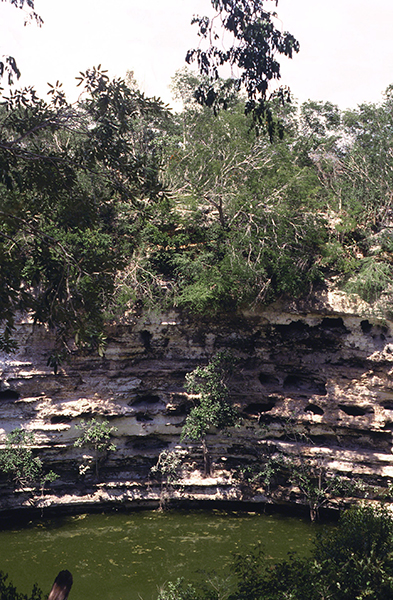 |
| Mexico, Sacred Cenote, Chichén Itzá. Photo © Davis Art Images, Photo: John Rosenthal. (8S-28835) |
The early Pre-Classic Mayans (ca. 1000 BCE–250 CE) occupied Chiapas in southern Mexico, Honduras, and Guatemala until between 400 and 50 BCE when they began to spread to the Yucatán Peninsula. After centuries of egalitarian village living, they adapted a hierarchic, autocratic, city-state way of life. Although the reasons for the change are unknown, the platform pyramids, organization of cities, and the rule of warrior-priests represent the influence of Olmec culture and that of another early city-state culture in Teotihuacán.
The Formative or Pre-Classic Period saw the development of major urban centers in many areas. The Classic Period (ca. 250–900 CE) continued the developments of the Pre-Classic Period. The era was one of prosperity and relative peace among the different regions. It ended with a period drought, which taxed the agricultural resources of the heavily populated urban areas. The older cities declined and new ones emerged during the Post-Classic Period (900–1520 CE) to become the centers of economic and military power.
Although the city of Chichén Itzá was built during the Classic Period, the grandest monuments such as the Pyramid of Kukulcán were built during the Late Classic Period (600–900 CE), either by Toltec invaders or under the influence of the Toltec, a culture centered in northern Mexico at Tula. An unknown calamity occurred around 900 CE in Chichén Itzá and a number of other Mayan cities, many of which were abandoned. During the Post-Classic Period, the cities were occupied by Toltec or Toltec-influenced peoples and rebuilt. The cities were abandoned again around 1300.
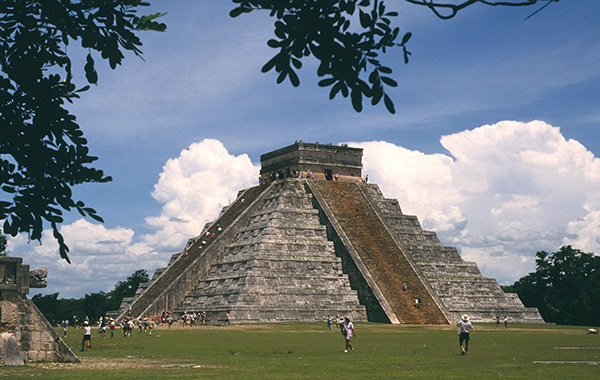 |
| Mexico, Pyramid of Kukulcán (the god Quetzalcoatl in Aztec), from the northeast, Chichén Itzá, 600s–900s CE. Image © 2020 Davis Art Images (8S-28814) |
The Pyramid of Kukulcán (named El Castillo, "the Castle," by the Spanish invaders) was actually a temple and, as was the case in all Mayan cities, the center of the city's political-religious life. The Pyramid of Kukulcán at Chichén Itzá was actually built (ca. 800–900 CE) over a smaller pyramid and temple. It was built of limestone, which was quarried nearby, and was dedicated to worship of the god Kukulcán (or Quetzalcoatl in Aztec), feathered serpent deity and god of creation. It represented the Mayan idea of the creator as a "Snake Mountain." This practice had been adopted earlier at Teotihuacán.
Like all pyramid construction in Mayan cities, the temple is a stepped pyramid with ceremonial stairways on all four sides. Although some Mayan pyramids contain the burial chambers of prominent rulers, their primary function was ceremonial (religious), unlike the tomb-pyramids of ancient Egypt.
The Mayans were great ancient mathematicians, developing the concept of zero long before western European cultures. If viewed from above, The Pyramid of Kukulcán, with its four stairways imposing a cross over the square pyramid, imitates the Mayan glyph for zero. The architects of the pyramid were so skilled with the calendar and solar position that at the spring and autumnal equinoxes, when the sun is setting, its shadow on the east side of the north stairs creates a zigzag shadow across the platforms, imitating a snake that culminates in the serpent heads at the base.
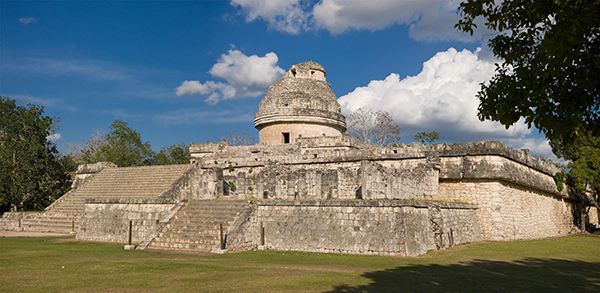 |
| Mexico, Observatory (Caracol), 900s–1200s, from northwest, Chichén Itzá. Photo by Fcb981. CC BY-SA 3.0. (8S-28838) |
The Observatory (Caracol) at Chichén Itzá may have been originally built by the Mayans before the arrival of peoples from the north. These people (Toltec or Toltec-influenced people) probably altered, enlarged it, or both. Although the upper part resembles the dome of an observatory (hence the modern name), it is actually the remnants of a cylindrical tower.
Whatever the case, the building is a graphic example of how sophisticated the Mesoamerican math and scientific understanding was. It seems to have been primarily oriented toward the movements of Venus. Venus had tremendous significance for the Maya. It was considered the sun’s twin and a war god. Mayan leaders used the changing position of Venus to plan appropriate times for raids and battles. Kukulcán, the feathered serpent god, is represented as Venus on the stairway relief of the Castle.
A circular platform tower provided sightlines for the equinoxes, the summer solstice, and the cardinal directions. The balustrade of the main stairway forms a serpent, much like on the stairs of the Pyramid of Kukulcán. The small platform-like structure to the right of the main stairway was added shortly before the late 1200s.
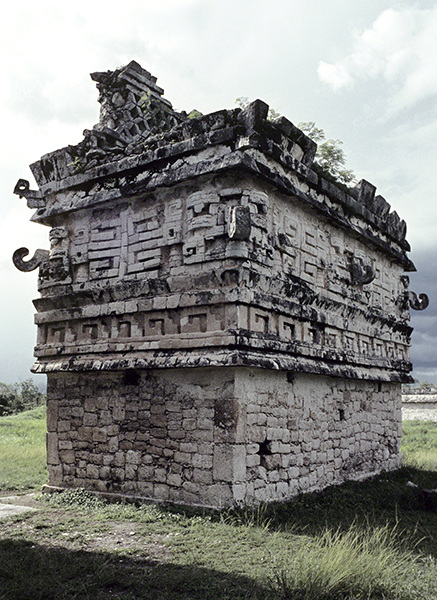 |
| Mexico, Small Temple, adjacent to the “Nunnery” (a palace), south and east sides, Chichén Itzá, 600s–700s CE. Image © Davis Art Images. (8S-11298) |
This small temple, called "Church," at Chichén Itzá is located next to a palace called the "Nunnery" complex. These names were given by Spanish invaders who compared everything to Christian buildings in their extremely limited cultural knowledge. The Church, along with the Nunnery, reflect the Puuc Mayan style of the Late Classic Period, a style particularly characterized by the mosaic stonework seen here in the second level under the gable molding.
The second level is decorated with hook-nosed Chac masks. Chac was the rain god, an important deity to the Mayans who relied on corn, beans and squash for subsistence. The Church was actually a small temple dedicated to Chac. The roof comb, a thin masonry decoration running the length of the building in the middle of the stone roof, was also typical of the Puuc Mayan style.
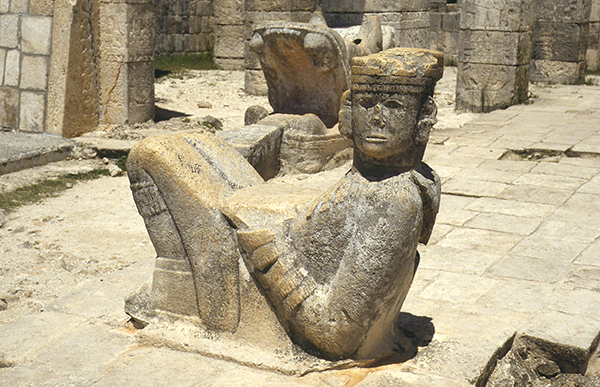 |
| Mexico, Chac-mool, figure on the top platform of the Temple of Warriors, Chichén Itzá, 900s-1200s CE. Image © 2020 Davis Art Images. (8S-28828) |
The fourth platform of the Temple of Warriors is surmounted by a small temple building that houses a chac-mool figure (a reclining sculptural form depicting a messenger of the gods) and a group of squared columns that once held wooden lintels to support a roof. Chac-mool means "great or red jaguar paw," which may associate this figure with the jaguar warrior guild. However, it is generally unclear where and when this figure evolved. These sculpted figures appear in Post-Classic Mayan and Aztec architecture.
Where the chac-mool appears in architecture, such as on the top of the Temple of Warriors at Chichén Itzá, it is in a place associated with the priests' activities. It is thought the purpose of the chac-mool figures was a place for sacrificial offerings to the gods. It may have also served as an altar for ritual human sacrifice.
Correlations to Davis programs: A Community Connection 2E: 1.5; A Personal Journey 2E: 8.5; The Visual Experience 3E: 14.4; Discovering Art History 4E: 4.9


Comments